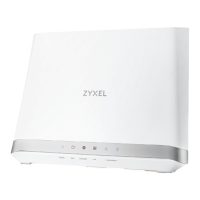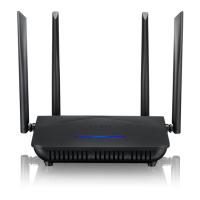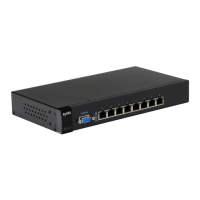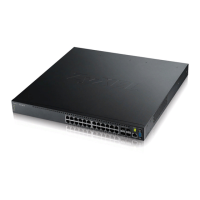Chapter 19 Classifier
XS3700 Series User’s Guide
164
The following table describes the labels in this screen.
Table 76 Advanced Application > Classifier > Classifier Configuration
LABEL DESCRIPTION
Active Select this option to enable this rule.
Name Enter a descriptive name for this rule for identification purposes.
Weight Enter a number from 0-65535 for the order priority of the Classifier rule. When the match
order is in manual mode, a higher weight means a higher priority. When the match order is in
auto mode, the priority depends on the layer of the item configured in the qualifier, with
layer-4 having a higher priority than layer-3, and layer-3 having a higher priority than layer-2.
Log Click the Log check box to record the number of matched packets in a particular time interval.
Count Click the Count check box to have the Switch count the number of matched packets.
Tme Range You must have configured a time range in the Time Range screen first. Select the name of
the time range rule from the drop-down list box to apply a time range to the Classifier rule.
Ingress Port
Port Choose Any for all ports or enter the ports manually to have the Switch apply the Classifier
rule on the ports.
Trunk Choose Any for all trunks or enter the trunks manually to have the Switch apply the Classifier
rule on the trunks.
Packet
Format
Specify the format of the packet. Choices are All, 802.3 tagged, 802.3 untagged,
Ethernet II tagged and Ethernet II untagged.
A value of 802.3 indicates that the packets are formatted according to the IEEE 802.3
standards.
A value of Ethernet II indicates that the packets are formatted according to RFC 894,
Ethernet II encapsulation.
Layer-2 fields configured in a classifier have a lower priority than layer-3 or layer-4 fields when the match
order is in auto mode.
VLAN Select Any to classify traffic from any VLAN or select the second option and specify the source
VLAN ID in the field provided.
Priority Select Any to classify traffic from any priority level or select the second option and specify a
priority level in the field provided.
Ethernet Type Select an Ethernet type or select Others and enter the Ethernet type number in hexadecimal
value. Refer to Table 78 on page 166 for information.
Source
MAC Address Select Any to apply the rule to all MAC addresses.
To specify a source, select the MAC buttonand type a MAC address in valid MAC address
format (six hexadecimal character pairs).
Mask Manually type the source MAC mask to which the rule should be applied. You may choose one
MAC mask only or all masks (Any).
Destination
MAC Address Select Any to apply the rule to all MAC addresses.
To specify a destination, select the MAC button and type a MAC address in valid MAC address
format (six hexadecimal character pairs).
Mask Manually type the source MAC mask to which the rule should be applied. You may choose one
MAC mask only or all masks (Any).
Layer-3 fields configured in a classifier have a lower priority than layer-4 fields when the match order is in
auto mode.
IP Packet
Length
Click Any to classify any size of packet length or manually enter a range of number (from/to)
of packet size in the field provided.

